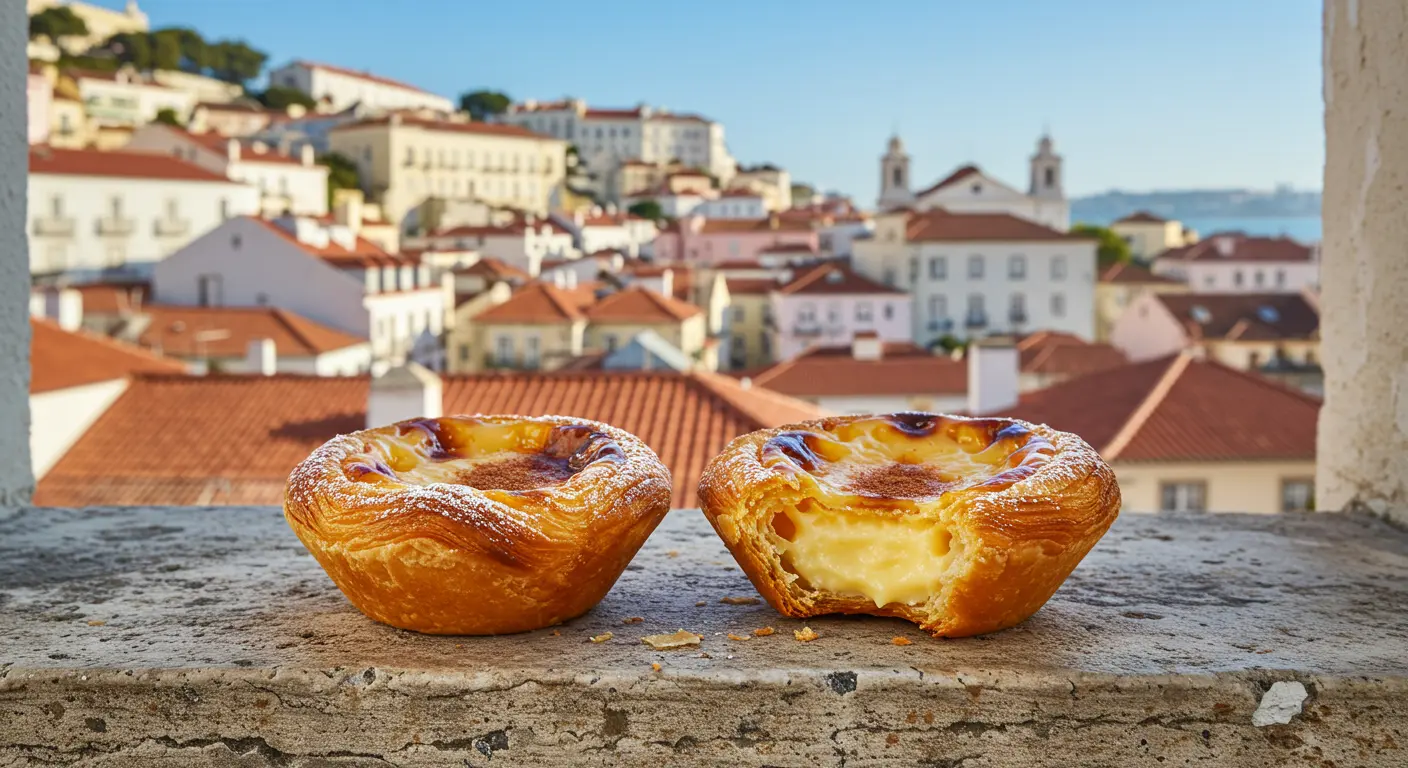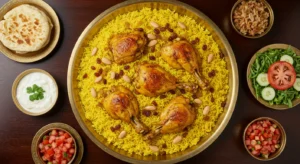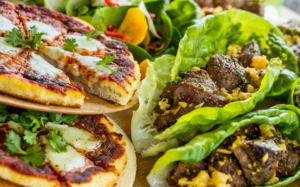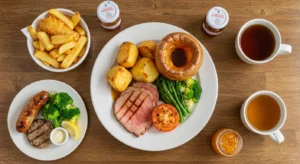Table of Contents
A Beginner’s Guide to the Soulful World of Portugal’s Food
You’ve seen the pictures. That perfect, flaky pastél de nata, dusted with cinnamon, sitting in a sun-drenched Lisbon café. It’s a beautiful image, but let me tell you a secret: that pastry is just the welcome mat. Portugal’s food is a deep, soulful, and surprisingly diverse universe waiting to be explored.
For a beginner, it can be a little overwhelming. Where do you even start? This isn’t just about finding a good restaurant; it’s about understanding a culture built around the table, the sea, and incredibly honest, flavorful ingredients. That’s exactly what we’ll do together. Consider this your friendly guide to the heart of Portuguese cuisine—no fancy jargon, just a passionate breakdown of what makes it so special, what you absolutely must try, and how to eat like a local.
We’ll move beyond the iconic custard tart to uncover hearty bread soups, sizzling grilled fish, and the one ingredient that appears in more dishes than you can count. Ready? Vamos lá! (Let’s go!)
The Foundation: What Makes Portugal’s Food Unique?
Before we dive into specific dishes, it helps to understand the personality of the cuisine. Portuguese food isn’t about complex, fussy sauces or molecular gastronomy. Its power lies in its simplicity and the incredible quality of its core components.
- The Sea is the Kitchen: With over 1,100 miles of coastline, it’s no surprise that seafood is the star of the show. The Portuguese don’t just eat fish; they have a specific name for every creature in the ocean, and they know how to cook each one to perfection. Grilling over charcoal is a national pastime.
- The Holy Trinity: Onion, Garlic, and Olive Oil: If you smell something delicious wafting from a Portuguese kitchen, chances are it starts with a slow sauté of onion and garlic in golden, fragrant olive oil. This base, called a refogado, is the foundation for countless stews, soups, and sauces.
- A Love Affair with Bread and Potatoes: Carbohydrates are not an afterthought here; they are essential tools for sopping up every last bit of flavor. From crusty, rustic pão to potatoes cooked in myriad ways, they provide the comforting backbone of a meal.
- Spices from an Age of Exploration: Portugal’s history as a global explorer left a delicious mark. You’ll find the warm, complex flavors of piri-piri chili, cinnamon, saffron, and bay leaf (often used fresh from the tree!) woven throughout their cooking.
Your Can’t-Miss Hit List: Iconic Portuguese Dishes
Okay, let’s get to the good stuff. Here’s a rundown of dishes that will give you a true taste of Portugal.
The Starters & Snacks (Petiscos)
Think of petiscos as Portuguese tapas—small plates perfect for sharing with a cold beer or a glass of vinho verde.
- Pão com Chouriço: This isn’t just bread with chorizo; it’s a magical, warm, fluffy bread baked with slices of spicy chouriço inside. The fat from the sausage melts into the dough, and it’s utterly irresistible.
- Bolinhos de Bacalhau: These golden, tear-shaped croquettes are a national obsession. Made from shredded salted cod (bacalhau), potato, parsley, and egg, then deep-fried to a crisp perfection. They’re fluffy on the inside and perfect with a squeeze of lemon.
- Queijo da Serra: A creamy, buttery, and slightly pungent sheep’s milk cheese from the Serra da Estrela mountains. It’s so soft you sometimes scoop it out with a spoon. Spread it on a piece of fresh bread for a simple, decadent treat.
The Main Events: Seafood & Meat
This is where Portugal truly shines. The mains are often hearty, generous, and full of character.
- Sardinhas Assadas (Grilled Sardines): A summer staple, especially during the Festas de Lisboa. These aren’t the tiny sardines from a can; they’re large, fresh, and grilled whole until the skin is crispy and the flesh is smoky. Eat them with your fingers, accompanied by a salad of boiled potatoes, peppers, and onions.
- Arroz de Marisco (Seafood Rice): Often called “Portuguese paella,” this is so much more than that. It’s a rich, soupy rice dish teeming with a variety of shellfish—clams, mussels, shrimp—and infused with a deeply concentrated seafood broth and a hint of tomato. It’s a celebration in a bowl.
- Francesinha: If you need comfort food, head to Porto. The “Little Frenchie” is a beast of a sandwich: layers of bread, ham, linguiça sausage, steak, and cheese, all smothered in a hot, slightly spicy tomato and beer sauce and topped with a fried egg. It’s an experience.
- Cozido à Portuguesa: This is the ultimate Portuguese stew. A hearty pot of boiled meats (chicken, beef, pork), sausages (like chouriço and morcela blood sausage), and vegetables (cabbage, carrots, potatoes). It’s a winter warmer that defines home cooking.
The Sweet Finale: Sobremesas
Portuguese desserts are often rich, egg-based, and influenced by centuries-old recipes from convents and monasteries.
- Pastél de Nata: We have to mention it! The king. The crisp, flaky pastry shell is filled with a creamy, caramelized custard. The best are still from the original shop, Pastéis de Belém in Lisbon, but you’ll find fantastic versions everywhere. The key is the sprinkle of cinnamon and powdered sugar on top.
- Sericaia: A classic from the Alentejo region, this is a soft, fluffy egg pudding, almost like a soufflé, baked and served with stewed plums (ameixas). The contrast between the warm, airy pudding and the sweet, tart fruit is divine.
The Elephant in the Room: Bacalhau (Salted Cod)
No discussion of Portugal’s food is complete without paying homage to bacalhau. It’s not just a dish; it’s a cultural icon. There’s a famous saying that there are more than 365 ways to cook bacalhau—one for every day of the year.
Why salted cod? It dates back to the Age of Discovery, when salting was the best way to preserve fish for long voyages. The tradition stuck. The fish is dried and salted so hard it looks like a wooden board. You have to soak it for 24-48 hours, changing the water, to rehydrate it and remove the salt before cooking.
Some classic preparations include:
- Bacalhau à Brás: Shredded cod with finely chopped straw potatoes, onions, scrambled eggs, and black olives.
- Bacalhau com Natas: Cod with cream and potatoes—the ultimate comfort food bake.
- Pastéis de Bacalhau: The croquettes we mentioned earlier.
A Taste of the Regions: It’s Not All the Same
Portugal may be small, but its regional variations are significant.
- The North (Porto & Douro): Hearty, robust food. Think of the Francesinha, rich stews, and the famous Tripas à Moda do Porto (tripe stew).
- Central Portugal: Known for its suckling pig (leitão) from Mealhada and the incredible cheese from Serra da Estrela.
- Lisbon & The Tagus Valley: A melting pot where you’ll find everything, but the seafood here is exceptional.
- The Alentejo: The breadbasket of Portugal. Expect hearty pork dishes, soups like açorda (a bread-thickened soup), and the bold flavors of the plains.
- The Algarve: Famous for its fresh seafood, especially clams (amêijoas) and cataplana (a seafood stew cooked in a unique copper clam-shaped pot).
Practical Tips for Your Culinary Adventure
- Drink Like a Local: Pair your meals with a crisp, slightly effervescent Vinho Verde (green wine) from the north or a robust Alentejo red. And of course, end a meal with a glass of Porto wine.
- Ordering Tips: Lunch is usually the main meal. Look for the “Prato do Dia” (Plate of the Day) for a great, affordable option. Don’t be shy about pointing to what you want if there’s a language barrier—enthusiasm is a universal language.
- Visit the Mercados: For a real sensory experience, visit a local market like Mercado da Ribeira in Lisbon or Mercado do Bolhão in Porto. It’s the best place to see the incredible quality of produce, fish, and meat that defines the cuisine.
To dive deeper into Portugal’s rich culinary history and regional recipes, a fantastic resource is Visit Portugal’s official food page, which is curated by local experts.
Frequently Asked Questions (FAQs)
Q: Is Portuguese food spicy?
A: Generally, no. It’s more about herbal and aromatic flavors. However, piri-piri sauce, a spicy chili sauce, is almost always available on the table for you to add heat to your chicken or fish if you wish.
Q: I’m a vegetarian. Will I find options?
A: It can be challenging, as many vegetable dishes are cooked with meat broth or chunks of meat. However, you’ll find delicious options like grilled vegetables, cheeses, omelets, caldo verde without the chouriço, and the classic salada mista. It’s always best to ask clearly: “Sou vegetariano/a. Tem algo sem carne ou peixe?” (I’m vegetarian. Do you have anything without meat or fish?).
Q: What is a typical breakfast in Portugal?
A: It’s usually a simple, light affair. Most locals have a coffee (an espresso, called a bica) with a pastry, like a croissant or a pastel de nata. It’s not a large, cooked meal.
Q: How important are meal times in Portugal?
A: Quite important! Lunch is typically between 12:30 PM and 2:30 PM, and dinner is late, often starting after 8:00 PM and going until 10:00 PM or later. Many restaurants will be closed in the late afternoon.
Q: Is it customary to tip?
A: Tipping is not obligatory, as service is usually included. However, it’s common practice to round up the bill or leave small change (€1-€5) for good service as a gesture of appreciation.
Your Delicious Journey Awaits
Portugal’s food is a story told in flavors—a story of the sea, the land, and a people who take immense pride in sharing their table. It’s about the joy of a perfectly grilled sardine, the comfort of a creamy pastél de nata, and the surprise of a complex wine you’ve never heard of.
So, go beyond the guidebook. Be curious. Order the dish you can’t pronounce. Sit at a tasca (a small, traditional tavern) and just watch the world go by. The real magic of Portuguese cuisine isn’t just in the eating; it’s in the experience.




